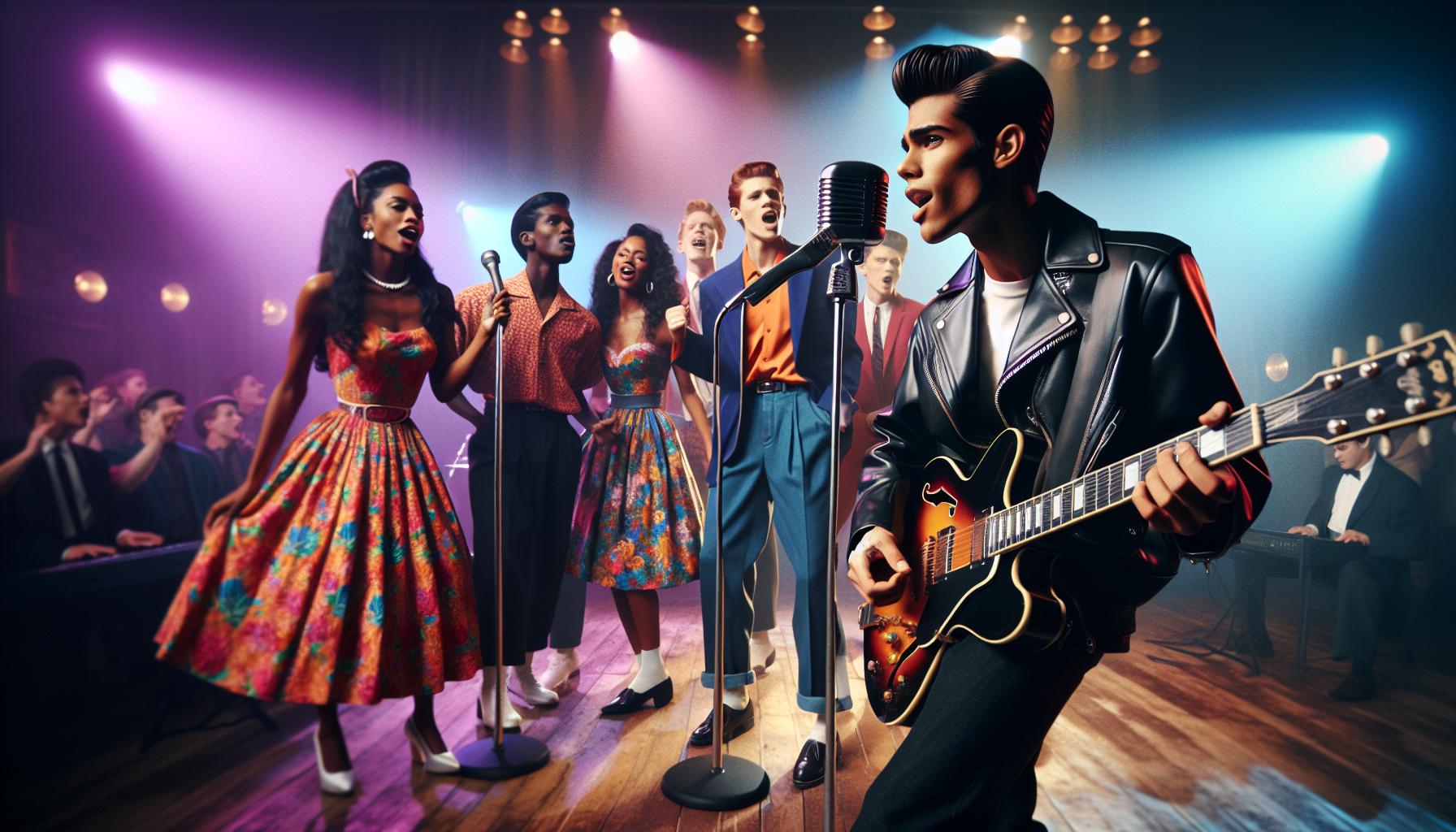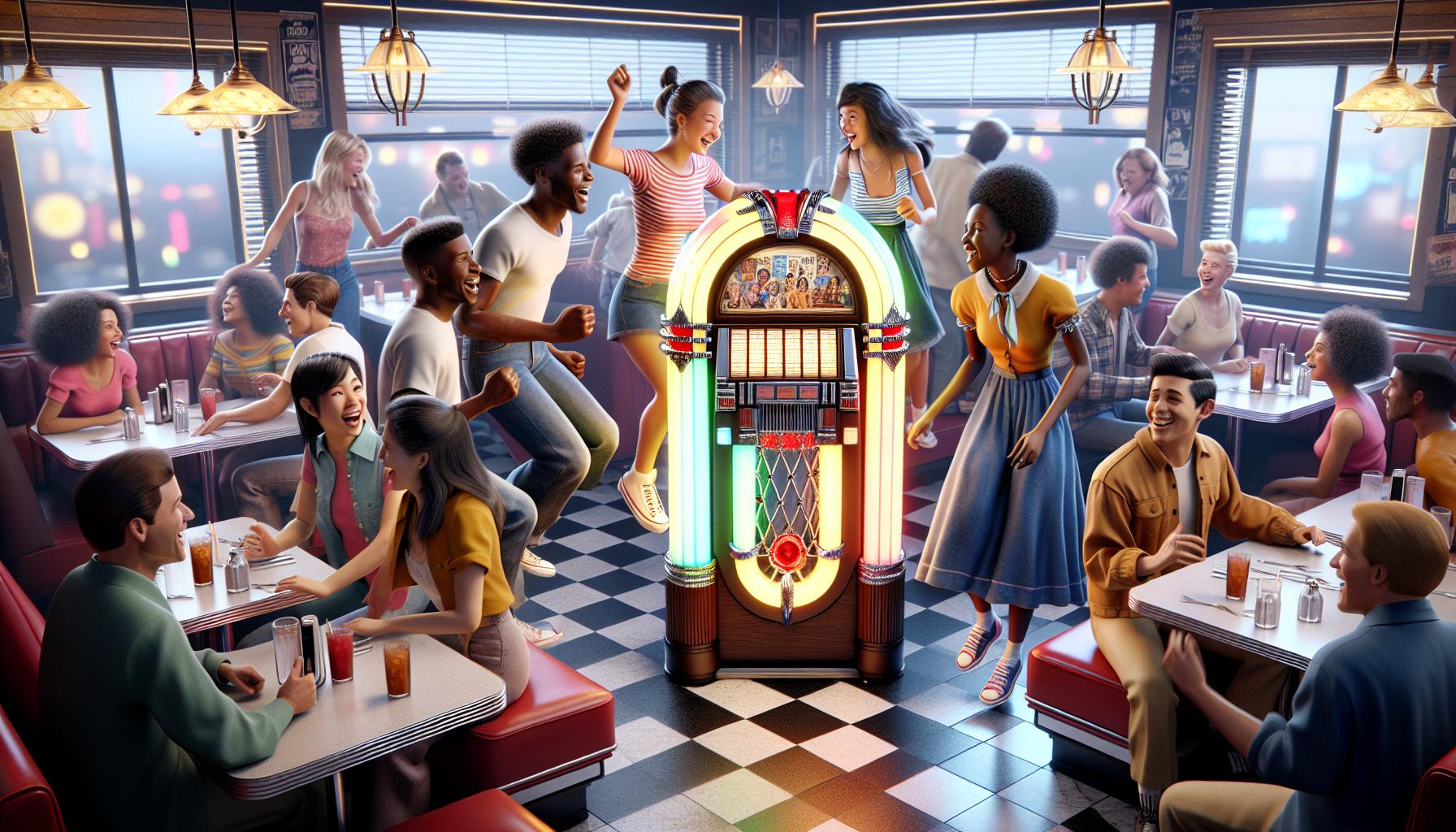The 1950s marked a transformative era in music, setting the stage for genres that would define generations. As rock ‘n’ roll burst onto the scene, it captivated audiences with its energetic rhythms and rebellious spirit. Icons like Elvis Presley and Chuck Berry emerged, blending rhythm and blues with pop to create a sound that resonated with the youth of the time.
This decade also saw the rise of doo-wop and the continued popularity of jazz and country music. Radio waves buzzed with innovation, as artists pushed boundaries and challenged societal norms. The music of the 1950s not only entertained but also reflected the cultural shifts of a nation on the brink of change, laying the groundwork for future musical movements that would continue to evolve.
Key Takeaways
- Emergence of Rock ‘n’ Roll: The 1950s saw the rise of rock ‘n’ roll, a genre that fused rhythm and blues with country music, captivating a youthful audience with its energetic and rebellious spirit.
- Influential Artists: Key figures like Elvis Presley and Chuck Berry shaped the era, with their iconic songs and performances laying the groundwork for future musical innovations.
- Doo-Wop Popularity: Doo-wop emerged as a significant genre, highlighting vocal harmonies and emotional themes, with groups like The Platters achieving widespread appeal.
- Technological Advancements: The jukebox and AM radio revolutionized music consumption, increasing accessibility to popular songs and promoting emerging artists.
- Cultural Reflections: 1950s music served as a powerful cultural force, reflecting social changes, youth identity, and promoting integration between African American and white music traditions.
- Legacy of the Decade: The musical developments of the 1950s laid the foundation for future generations, influencing various genres and continuing to inspire contemporary artists.
Music 1950s
The 1950s marked a pivotal decade in the evolution of music, characterized by the explosive growth of rock ‘n’ roll. This new genre emerged from the fusion of rhythm and blues, country, and jazz, attracting a youthful audience eager for change. Artists like Elvis Presley, often referred to as the “King of Rock and Roll,” and Chuck Berry, known for hits like “Johnny B. Goode,” played crucial roles in popularizing this sound.
Doo-wop gained prominence during this decade, with groups like The Platters and The Drifters delivering smooth vocal harmonies. The style, known for its catchy melodies and romantic themes, resonated with listeners and became a staple of the era. Jazz also maintained its influence, as legends like Miles Davis and John Coltrane continued to evolve the genre’s boundaries.
Country music saw significant changes as well, with artists like Johnny Cash and Patsy Cline striving for mainstream appeal. Their crossover hits showcased a blend of traditional elements and contemporary sounds, broadening the genre’s audience.
The 1950s served as a musical watershed, reflecting the social transformations of the time. The rise of teenage culture, heightened by the advent of television and radio, amplified the reach of these new genres. Music became a vehicle for expression, mirroring the aspirations and struggles of a generation seeking identity and change. This decade not only catered to popular tastes but also laid the groundwork for future musical innovations.
Key Genres That Defined The Era

The 1950s showcased a diverse music landscape, with new genres prominently shaping the musical identity of the decade.
Rock And Roll Revolution
Rock ‘n’ roll emerged as a dominant genre, marked by a fusion of rhythm and blues with country influences. Artists like Elvis Presley and Chuck Berry defined the sound, captivating audiences with upbeat tempos and catchy melodies. The electric guitar took center stage, creating a revolutionary sound that appealed to the youth. Hits like “Jailhouse Rock” and “Johnny B. Goode” became anthems of a generation. The genre not only transformed popular music but also challenged social norms, helping to pave the way for future musical movements and cultural shifts.
The Rise Of Doo-Wop
Doo-wop gained traction during the 1950s, characterized by vocal harmony and simplistic melodies. Groups like The Platters and The Drifters popularized the style, with smooth harmonies and heartfelt lyrics resonating with audiences. Notable songs like “Only You” and “Under the Boardwalk” epitomized the genre’s charm. Doo-wop reflected the emotional landscape of the era, bridging the gap between rhythm and blues and rock ‘n’ roll. This genre not only provided a platform for African American artists but also influenced the development of pop music in subsequent decades.
Influential Artists Of The 1950s

The 1950s produced several influential artists whose contributions shaped the music landscape. Their styles, innovations, and cultural significance continue to resonate.
Elvis Presley: The King Of Rock
Elvis Presley revolutionized music with his unique blend of rock ‘n’ roll, pop, and rhythm and blues. His energetic performances, distinctive voice, and dynamic stage presence captivated audiences. Chart-topping hits include “Heartbreak Hotel,” “Hound Dog,” and “Suspicious Minds,” solidifying his status as a music icon. Elvis’s collaboration with legendary producers like Sam Phillips and his televised performances transformed the music industry. His cultural impact extended beyond music, influencing fashion, dance, and youth culture. Presley’s ability to cross genres helped break racial barriers and opened doors for future artists.
Chuck Berry: Pioneer Of Rock Music
Chuck Berry laid the groundwork for modern rock music with his innovative guitar riffs and storytelling lyrics. His seminal tracks, such as “Johnny B. Goode,” “Maybellene,” and “Roll Over Beethoven,” showcased his mastery of rhythm and blues. Berry’s signature guitar style and energetic performances set the standard for rock guitarists. He popularized the use of the electric guitar, merging blues with a new, youthful sound. His influence extended to various genres, impacting artists like The Beatles and Bob Dylan. Chuck Berry’s contributions to the music scene exemplified the spirit of the 1950s, making him a central figure in rock history.
Impact Of Technology On Music

Advancements in technology during the 1950s significantly transformed the music landscape, shaping how audiences experienced and consumed music.
The Birth Of The Jukebox
The jukebox revolutionized music accessibility in the 1950s. Jukeboxes allowed patrons in bars and diners to select their favorite songs, introducing a new level of interactivity. Coin-operated devices featured an array of popular tracks, bringing rock ‘n’ roll and rhythm and blues to the forefront of social gatherings. By 1955, nearly 100,000 jukeboxes operated across the United States, playing a crucial role in promoting emerging artists. This technology effectively democratized music, enabling diverse genres to reach wider audiences, particularly youth who sought connection to contemporary sounds.
The Importance Of Radio
Radio became a dominant force in music distribution during the 1950s. AM radio’s reach soared, connecting listeners to their favorite artists and new musical trends. DJs emerged as influential figures, introducing audiences to rock ‘n’ roll hits and promoting talents like Elvis Presley and Chuck Berry. Formats like Top 40 playlists solidified popular tracks, ensuring that chart-toppers gained significant airplay. Specifically, radio broadcasts made it easy for fans to tune into live performances, contributing to the sense of community among listeners. By the end of the decade, radio solidified its role as a primary medium for music enjoyment, shaping public taste and driving the success of countless artists.
Cultural Significance Of 1950s Music
1950s music played a crucial role in shaping cultural identity. Rock ‘n’ roll emerged as the predominant genre, revolutionizing youth expression. The music captured the sentiments of a generation eager for change, reflecting aspirations and social realities. The blend of rhythm and blues with pop resonated powerfully among teenagers, fostering a sense of belonging and rebellion.
Significant social movements found voice in this musical landscape. Rock ‘n’ roll challenged racial segregation, integrating African American and white musical traditions. Artists like Chuck Berry became pivotal figures in bridging gaps, influencing future generations while promoting cultural exchange. Songs from this period often expressed themes of love, freedom, and youth empowerment, resonating with listeners seeking meaning in their experiences.
The 1950s also marked the rise of teenage culture. Music became a soundtrack for social events, from sock hops to drive-in theaters. Names like Elvis Presley became synonymous with youth rebellion, as performances appealed to a generation eager to break free from conservative norms. The hybridization of genres created new fan bases, connecting diverse communities through shared musical experiences.
Technological advancements reinforced the cultural impact of 1950s music. The jukebox revolutionized how music reached listeners, offering increased access to popular songs. With nearly 100,000 jukeboxes operating by 1955, music became an integral part of social gatherings. AM radio further amplified this impact, introducing diverse artists and tracks to captivated audiences. This widespread distribution solidified the role of music as a central aspect of American life.
Overall, 1950s music acted as a powerful cultural force. It shaped societal perspectives, influenced fashion, and transformed communication among youth. The legacy of this decade continues to resonate, as it laid the groundwork for future musical movements and continues to inspire modern artists.
Indelible Mark On American Culture
The music of the 1950s left an indelible mark on American culture. It not only entertained but also reflected the evolving social landscape of the time. With the rise of rock ‘n’ roll and influential artists like Elvis Presley and Chuck Berry, a new era of youth expression emerged.
Technological advancements in jukeboxes and radio played a crucial role in shaping musical tastes and expanding accessibility. This decade was a transformative period that bridged cultural divides and fostered a sense of community among listeners.
The legacy of 1950s music continues to resonate today, inspiring new generations of artists and shaping the sound of modern music. Its influence is a testament to the power of music as a vehicle for change and connection.